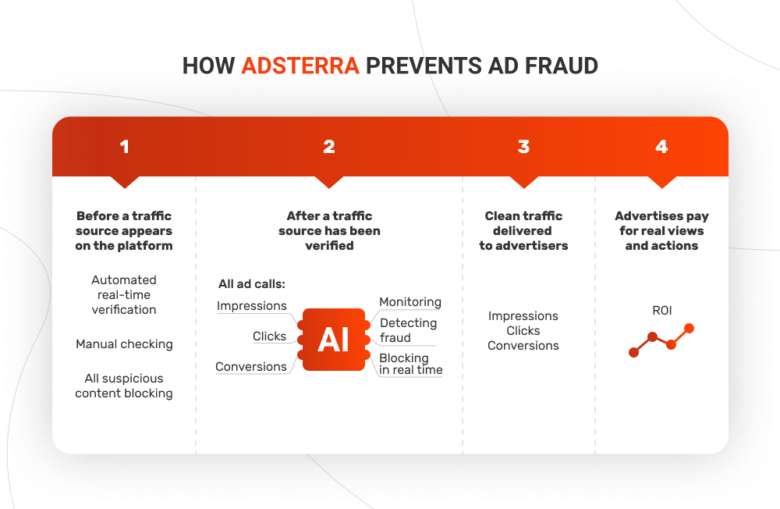While publishers are concerned about staying safe from malvertising, advertisers and affiliates care a lot about getting quality, clean traffic from trusted websites. Traffic fraud schemes have become too frequent to ignore them.
The Adsterra Policy Team reveals how advertisers and affiliate marketers can stay safe from ad fraud traffic including fake impressions, clicks, conversions, and many more threats.
If you had ever encountered fraudulent techniques, wondered “Is Adsterra an ad fraud actor?” or “How to protect my advertising budgets?”, you should share 8 minutes with this guide. Let’s break down all whats and hows!
What is ad fraud traffic and what’s its purpose?
Like those absolutely genuine and clean traffic growth techniques, bot and fraud methods pursue the very same goal — monetization. Some publishers use these methods to get higher payouts from impressions, clicks or even conversions.
Fraud traffic is literally the opposite of real users that see ads, click on them and complete target actions (conversions). Publishers use it to wangle extra CPM or money when they don’t have enough website users.
When a publisher or webmaster realizes they need more impressions or clicks to ensure high CPM, they usually seek for white-hat SEO methods or legitimate user acquisition. But some of them decide to cheat the system. They would impersonate real humans with bots: millions of bots would imitate paid actions draining advertising budgets.
Are ad networks interested in fraud activities?
One may think that advertising platforms are also interested in generating multiple fake impressions or clicks so as to win in their commission. Well, that’s far from reality. This way would lead any advertising network or platform to a complete downfall as any attempt to speculate on traffic is easily disclosable.
Why are fake impressions and clicks harmful for ad networks?
First off, false actions never bring leads or purchases. Every marketer would detect that they get dull impressions that don’t convert and refuse to use the network.
Another point proving that fraudulent traffic is something ad networks avoid by all means — transparency of conversions tracking. Each reputable network collaborates with powerful tracking systems that detect suspicious clicks and conversions. With tracking solutions like Voluum or Binom — who we partner with — and which many of our advertisers use, it is impossible to keep shady methods like impressions inflating in secret.
Eventually, ad networks suffer from faux traffic and other harmful activities on a par with their advertisers, as they can lose their clientele, their reputation, and … any chances to recover.
Most common offensive techniques, and how Adsterra ad fraud protection works
Having figured out what’s the purpose of malicious activities against advertisers, it is much clearer how and when they can be implemented. There are several most common techniques of impersonating real users’ behavior. There are too many of them to list them all, so we will cover some of the most frequently used.
1. Ad fraud techniques of showing hidden or extra ads
These are invisible ads that unreliable publishers can blend in the general feed trying to get larger payouts.
- A 1×1 pixel iframe imitating an ad on a publisher’s website.
- Multiple resized and copied/pasted ad codes.
- Ads are displayed outside of the viewport.
| The Adsterra ad fraud and hidden ads prevention and removal techniques |
| Adsterra ecosystem is transparent: we always know exactly which ads are exposed on which websites. Any attempt of mixing extra, non-unique ad scripts will be detected and blocked along with the traffic source that streams fake ad codes. Each impression is under control. If a publisher copies and pastes a unique script for, say, a banner, several times, we won’t count extra impressions. Moreover, we limit the quantity of similar scripts code per website: to expose 2 or 3 formats of the same type, a publisher needs to request it from our Support Team and pass the verification procedure. |
2. Ad fraud practices of traffic sources replacement
It is also called “impressions and clicks laundering” because instead of showing ads on the website that advertisers target, publishers mix some low-quality sources with totally invalid traffic.
So, advertisers partly pay for users they don’t need at all or even for bots. To make this possible, publishers use multiple redirects hoping that advertisers and ad networks won’t find out the substitution.
| Methods of redirects and traffic laundering prevention and removal |
| Adsterra algorithms are constantly monitoring each traffic source with several scanning techniques. They can detect a redirect attempt and mark it as a suspicious activity. The algorithms will check all impressions that come from this or that source and block it when they disclose fake traffic. |
3. Bot traffic, botnets and Methbot techniques
Bot traffic acquisition
There are webmasters who want to gain higher Alexa ranks and CPMs and, as a result, generate revenues faster, but they can’t provide enough users from a specific GEO. Some of them turn to legitimate actors and buy real human views and clicks. However, some of them turn to shady techniques like acquiring bot/fake traffic. Bots come from compromised user devices and imitate real user actions.
Botnets and click farms
Another type of faux traffic are botnets. These are large institutions that hold thousands of “ghost sites.” These websites provide no content but ad placements. Bots come to these sites and click on banners or other formats, while the botnets’ owners get paid while advertisers and ad networks get…nothing and lose their investment. Sometimes, botnets appear after malware attacks a network of computers turning them into bots.
Click farms act the same, only the actions they disguise are user clicks on ads, likes and comments (when it comes to social networks). Both botnets and click farms inflate real traffic or totally replace it by fake impressions or clicks.
Methbot
Methbot is a more sophisticated fraud technique to disguise real human actions. It can easily send fake clicks and mouse movements, false login data, geolocation replacement, etc.
Usually, the scheme uses a chain of dedicated proxy servers to make it harder to detect where the traffic comes from. Methbot can imitate even credible websites, fabricating their design and creating faux ranks.
| Ways of protecting advertisers from bots, botnets, and methbot schemes |
| Though the schemes mentioned above are the most advanced, the methods to prevent them ensure near-100% efficiency. At Adsterra, we combine AI-driven algorithms and manual checking to verify each ad call. All websites and apps that stream massive impressions (even premium websites) are being continually monitored to guarantee they send 100% human views, clicks, and actions. Next, we will outline how the Adsterra ad fraud prevention and detection solutions work. |
How Adsterra prevents, monitors, and blocks ad fraud traffic
Reacting to fraudsters’ activities is a far too poor method of protecting advertisers, that’s why Adsterra has developed a multi-level security ecosystem where every ad call from every source is under control.
The ecosystem of safety includes:
- a 360-degree analysis of any new traffic source with AI-powered algorithms and human agents;
- monitoring of the existing traffic which means checking impressions, clicks, and conversions (e.g., installs, opt-ins);
- real-time websites’ activity checking: response speed, newly-added GEOs, and formats requested.
On the infographics below there is a brief overview of how Adsterra ad fraud prevention system works.

Which anti-fraud solutions provide maximum safety?
Whenever you apply to ad networks, exchanges or RTB platforms, you should read through their guides (like the one you are reading right now) or ask their support team about how their anti-fraud security systems work. What’s important is that there must be 360-degree protection. What does it mean? First off, you must be sure that the Support team of your ad network is accessible. Nevermind of the AI or machine learning under the hood, there must be humans who are ready to answer you and come to the rescue.
It’s great when your advertising platform has its own Policy Team or Anti-Cheat Team with in-house developers. These are pros who develop and elaborate solutions to monitor and beat malicious traffic.
Next comes the architecture of the security system. Ask if the network you work with uses reputable third-party security algorithms or in-house solutions. Make sure they are ready not only to block but also to prevent any attacks and ad hijacking.
Are automatic ad fraud prevention solutions enough?
With hacker techniques blooming, there is probably no actor on the market who will swear its solutions can predict and block 100% of fraudulent moves. If there are those, well, we can’t call them genuine.
The core technique of a successful battle against any malicious actions is never-ending development and timely human backup.
We at Adsterra invest a lot in both algorithms and human proficiency. While developing our in-house fraud prevention and removal solutions, we’re holding the Policy Team.
The Adsterra Policy Team carries out research on threats, tests new algorithms, and checks all suspicious inventory. It is also responsible for manual checking of inventory.
Campaigns’ protection and fraud traffic prevention as a win-win strategy
Despite many beliefs, advertising networks suffer from fraud traffic and fake clicks just the same as advertisers and agencies. Adsterra ad fraud prevention is a complex of measures to combat malicious activities.
The Adsterra multi-level security comprises:
- real-time ad fraud detection and prevention from any device and OS,
- ongoing GEOs and traffic sources’ monitoring with in-house AI-powered algorithms,
- additional manual verification of the newly-added traffic sources.
- fast inventory blocking after detecting ad fraud.
We believe that investment in anti-fraud algorithms is a win-win strategy as we treasure partnership with over 12K reputable advertisers who can enjoy:
- their budgets spent on real users they target,
- transparent conversion tracking,
- fair and higher campaigns’ KPIs: CTRs, clicks, installs.
Conclusion
Thank you for showing your interest in Adsterra security and anti-fraud systems. You can test the Platform yourself by creating a campaign with any of the profitable advertising formats.
